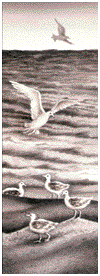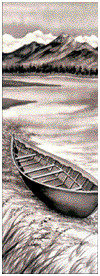

Teaching With Go Home, River
 THIS BOOK BEGAN as a teaching story for my own children.
The story contains two parallel lessons, one on the water cycle and the other on traditional
Iņuit (Eskimo) travel and trade networks. You can read more about Iņuit life on the
Iņuit page.
On this page, I discuss the water cycle and weather systems lessons
that can be taught with Go Home, River.
I have included an example of a simple related writing exercise
for early elementary students.
THIS BOOK BEGAN as a teaching story for my own children.
The story contains two parallel lessons, one on the water cycle and the other on traditional
Iņuit (Eskimo) travel and trade networks. You can read more about Iņuit life on the
Iņuit page.
On this page, I discuss the water cycle and weather systems lessons
that can be taught with Go Home, River.
I have included an example of a simple related writing exercise
for early elementary students.
 The young boy in Go Home, River
sees how river and ocean, fog and clouds, rain
and snow are endlessly being transformed one to another.
When I visit schools to read and
talk about the book, I ask young children questions like:
"Do rivers really float home in the clouds?"
"What are clouds made of?"
"What is the difference between clouds and fog?"
"How does water get into clouds and fog?"
"If a raindrop fell on your nose, where would it go?"
The essential idea for children is that water is all around us all the time.
Sometimes we can see it, but most of the time we cannot.
What we can't see is the really interesting part.
Moreover, if you understand the movement of water in the atmosphere,
then you will better understand weather in general.
The young boy in Go Home, River
sees how river and ocean, fog and clouds, rain
and snow are endlessly being transformed one to another.
When I visit schools to read and
talk about the book, I ask young children questions like:
"Do rivers really float home in the clouds?"
"What are clouds made of?"
"What is the difference between clouds and fog?"
"How does water get into clouds and fog?"
"If a raindrop fell on your nose, where would it go?"
The essential idea for children is that water is all around us all the time.
Sometimes we can see it, but most of the time we cannot.
What we can't see is the really interesting part.
Moreover, if you understand the movement of water in the atmosphere,
then you will better understand weather in general.
 My own interest in the water cycle and weather developed
from my experiences as a pilot who spent a lot of time camping in remote Alaska.
I had to understand weather better for my own safety.
I began to see the atmosphere as great rivers and oceans of air flowing
and circulating above the earth, just as rivers and oceans of water flow and circulate on the earth.
My own interest in the water cycle and weather developed
from my experiences as a pilot who spent a lot of time camping in remote Alaska.
I had to understand weather better for my own safety.
I began to see the atmosphere as great rivers and oceans of air flowing
and circulating above the earth, just as rivers and oceans of water flow and circulate on the earth.
 Air even behaves like water in many ways. For example, when air flows over mountains,
the mountains create turbulence
just as boulders create turbulence in flowing water. Air pressure is greatest at the bottom of the
atmosphere (at sea level), just as ocean pressures are greatest in the deep trenches.
Air even behaves like water in many ways. For example, when air flows over mountains,
the mountains create turbulence
just as boulders create turbulence in flowing water. Air pressure is greatest at the bottom of the
atmosphere (at sea level), just as ocean pressures are greatest in the deep trenches.
 When you see the atmosphere as
fluid and dynamic, weather begins to make more sense. When air flows over mountains,
it is lifted. At higher altitudes air pressure decreases, so rising air expands.
As air expands it cools (the same principle behind refrigerators and air conditioners).
Cool air holds less water, so any water in the air is more likely to become visible as clouds or fog,
or fall as rain or snow. Pilots like to say, "mountains make weather." Anyone who lives around mountains will tell
you how true that is.
When you see the atmosphere as
fluid and dynamic, weather begins to make more sense. When air flows over mountains,
it is lifted. At higher altitudes air pressure decreases, so rising air expands.
As air expands it cools (the same principle behind refrigerators and air conditioners).
Cool air holds less water, so any water in the air is more likely to become visible as clouds or fog,
or fall as rain or snow. Pilots like to say, "mountains make weather." Anyone who lives around mountains will tell
you how true that is.
 Not to oversimplify meteorology, but the atmosphere is basically a big energy transfer system,
moving heat from one place on the globe to another. All the air on earth wants to be the
same temperature, but the heat of the sun, the tilt and rotation of the earth,
and differences in the earth's surfaces frustrate air's search for equilibrium.
So we have massive rivers and oceans of air running all over the planet,
carrying heat and moisture from the tropics to the arctic, and never quite catching up.
Not to oversimplify meteorology, but the atmosphere is basically a big energy transfer system,
moving heat from one place on the globe to another. All the air on earth wants to be the
same temperature, but the heat of the sun, the tilt and rotation of the earth,
and differences in the earth's surfaces frustrate air's search for equilibrium.
So we have massive rivers and oceans of air running all over the planet,
carrying heat and moisture from the tropics to the arctic, and never quite catching up.
 Well, I am getting rather far from our story.
But isn't that is why stories are such wonderful teaching devices? Stories can launch us on a journey of
exploration to unexpected and interesting places.
Go Home, River is just one of a number of Alaska Books
with rich classroom possibilities.
Well, I am getting rather far from our story.
But isn't that is why stories are such wonderful teaching devices? Stories can launch us on a journey of
exploration to unexpected and interesting places.
Go Home, River is just one of a number of Alaska Books
with rich classroom possibilities.From Alaska Northwest Books
For information contact Jim Magdanz
To Order, Click On a Bookstore Link
 The Inuit
The InuitThe Story
Reviews
News
 For Teachers
For TeachersThe Author
Author Visits
Alaska Books
Guest Book
Site Awards
Site Map